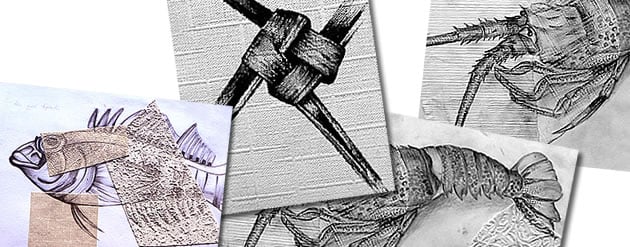Last Updated on April 2, 2023
This article provides guidance for teachers who need to equip a classroom for high school Painting / Fine Art students – or for students who wish to purchase their own art supplies, ensuring that they are well-prepared for their high school Art course. Papers and other materials are recommended by Amiria Robinson, an experienced teacher of Cambridge IGCSE and A Level Art & Design.

If you are interested in seeing artwork that has been completed using the materials recommended here, please view this 100% AS Art Coursework Project, 99% IGCSE Art Coursework project, and 98% IGCSE Coursework project.
Note: This collection of papers (and other drawing and painting surfaces) is designed to accompany a teaching programme that has an emphasis on acrylic and mixed media. It is not intended to be a ‘perfect’ list, but rather a sound base that can be tweaked and modified to suit individual teaching programmes as required!
General Purpose Drawing and Painting Papers
Wet Strength Cartridge Paper 130gsm
This is a standard cartridge paper, suitable for almost all drawing and painting exercises. It is suitable for wet and dry mediums, sketches, composition plans and quick exploratory exercises. An ample supply should be available for students in A3 and A2 sizes.
Wet Strength Cartridge Paper 180gsm
A sturdier and heavier weight paper than above, this is suitable for almost all drawing and painting exercises. It is especially useful for important artworks or those which require a heavier, stronger painting surface. (A1 sheets are also suitable for mounting preparatory work on if posting away for assessment). An ample supply of this paper should be available in A3 size.
Wet Strength Cartridge Paper 230gsm
This strong and heavy paper provides a sturdy base to work over and is suitable for supporting textural elements within a painting. Erasing lines can disturb the surface on this paper, so it is less useful for graphite drawings (however producing a rendered drawing on this paper is possible if an eraser is not used). This paper is typically used by students for final pieces and important preparatory artworks. An ample supply of this paper should be available for students, although its use may need to be monitored to minimise wastage (this paper is more expensive than the two above).

Supplementary papers, cardboard and other painting or drawing Surfaces
In addition to the papers described above, the following materials (or their equivalent) should be available in smaller quantities. These materials are used in whole sheets for individual artworks or are torn or cut into smaller pieces to use for mixed media backgrounds in sketchbook pages or artwork.
Kraft Paper
This is the same paper that is used to make brown paper bags. It is great for using as a mid-tone in charcoal drawings. A relatively inexpensive paper, this is best purchased in a thicker weight (i.e. 140gms) and in A3 reams.

Black Drawing Cartridge
Useful for dry mediums, such as white charcoal, this is an essential paper for students to experiment with. A light weight paper is usually all that is needed for dry drawing mediums, however, heavier papers such as black Malmero paper, 145gsm, or Stonehenge are also available. (Note: Do not use black sugar paper – this lightens rapidly when exposed to sunlight).

Canson Mi-Teintes 160gsm – assorted colours
This paper is lightly textured on one side and smooth on the other. Although expensive, only a few sheets of this paper (earthy, subtle colours such as browns and greys are usually ideal) are needed – able to be cut into small pieces for students to experiment with.

Watercolour Paper, such as Fabriano 200gsm
Only a few sheets of this paper are needed, so that students can experiment using watercolours and other liquid mediums (unless, of course, students are specialising in watercolours – in which case much more is needed)!

Assorted Textured Papers
Handmade papers have beautiful textures and are great for incorporating within paintings. It is also also possible to purchase assorted packs of machine-made textured papers which are very useful.

Tissue Paper
Acid free tissue paper can be crumpled and glued to paper using PVA, creating a textural surface to work over.

Tracing Paper
This is useful for developing ideas, overlaying on top of sketches to refine composition etc, or as an exciting surface to draw upon itself. This is easiest to keep in pristine condition when purchased in an A3 or A4 pad form. Waterproof drafting film (also known as Permatrace) is also amazing to draw or paint upon. This is a translucent plastic sheet which doesn’t warm when wet mediums are applied.

Canvas paper
A small roll of prepared canvas, or a canvas pad is great to have available in the classroom. As with above, small quantities are typically used, glued to preparatory sheets or sketchbook pages to provide a varied drawing / painting surface.

Lightweight Cardboard
A thin, lightweight cardboard that is easy to cut with a craft knife or scissors is useful for creating sculptural elements and raised areas within a painting.

MDF Panels
Although heavy materials are not advisable for those who post their work overseas for assessment, this can be a great painting surface for other students. If you ask nicely, the Technology Department at a school may even cut this into specific shapes for you!

Other Found Painting and Drawing Surfaces
In addition to the materials above, there are a range of other free drawing surfaces that can be invaluable in a classroom situation: old decorative and textured wallpapers, book pages, newspaper etc. See this article about inventive materials to draw or paint on for ideas!
Journals and Sketchbooks
Recommendations for these will be detailed shortly in an upcoming article.


